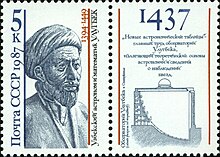Ulugh Beg
Ulugh Beg ,میرزا محمد طارق بن شاه رخ الغبیگ Mīrzā Muhammad Tāriq ibn Schāh-Ruch Ulugh-Beg , (born March 22, 1394 in Soltanije , Iran ; † October 27, 1449 in Samarkand , murdered; alternatively: Uluğ Bey , Ulugh Bek , Uluġ Beg ) was a Timurid prince in Samarkand . He is known as an astronomer and a martyr of science. The name Ulugh Beg is actually a title and generally means Great Ruler in Turkish .
Ulugh Beg was a son of Shah Ruch and his art-loving wife Gauhar-Schad and thus one of the grandsons of the conqueror Timur Lenk (Tamerlan). His father prevailed in 1407 in the succession struggles among the heirs of Timur and made Herat his capital in 1409 . In order not to give up the original capital, the 15-year-old Ulugh Beg was appointed governor in Samarkand , initially under tried and tested tutelage. Ulugh Beg ruled largely independently: he provided his father with troops, but rarely visited him and even appointed a Khan as nominal ruler, which should not have pleased the father. But his coins bore the name of Shah Ruchs.
The viceroy was engaged in mathematics and astronomy . Then came art, poetry and studying the Koran . In 1417/20 he founded the Ulugh-Beg-Madrasa (higher educational institution, with 60 to 70 scholars) in Samarkand, and in 1428 the Gurchani Zidsch observatory . The scientists al-Kaschi , Qadi Zada and Ulugh Beg calculated the sidereal year to be 365 days, 6 hours, 10 minutes and 8 seconds (with an error of 58 seconds compared to today's value). Furthermore, the star catalog Zidsch-i-Sultani was created between 1420 and 1437 with the position information of 1018 and 992 stars. Ulugh Beg built on the work of Muhammad ibn Musa al-Chwarizmi (approx. 780–850 mathematics, astronomy) and Ptolemy (approx. 90–160 astronomy). In 1830 Johann Heinrich von Mädler honored his astronomical work by naming the Ulugh Beigh moon crater.
As a ruler, however, Ulugh Beg was less successful. After the death of his father Shah Ruch in 1447, he got into trouble because the takeover of power in Herat did not go smoothly. All the princes played against each other on unclear fronts, the country was damaged and he could not be sure of the loyalty of his son Abd al-Latif. There were several arguments between the two. External enemies took advantage of the unrest: The Timurids lost the Syr-Darya area to the founder of the Uzbek khanate , Abu'l-Chair Khan , who at that time advanced as far as Samarkand and attacked Ulugh Beg's troops on the Amu-Darya .
The popular clergy ( Sufis , dervishes ) were not enthusiastic, because Ulugh Beg placed science above faith and certainly above his duties as a sultan. There were also numerous festivities. His son Abd al-Latif (murdered 1450) had him deposed at the instigation of the Hodja Ubaidullah Ahrar († 1490), a friend of small farmers and socially disadvantaged people. Ulugh Beg was defeated at Samarkand after the clergy apparently instigated repeated unrest in the city. He found no refuge in Samarkand, surrendered and was sent on a pilgrimage, during which he was arrested and executed. The observatory was destroyed, but an astronomer with the star tables escaped. The site of the observatory was discovered and excavated by Russian archaeologists in 1908.
Ulugh Beg is attributed: “The religions disperse like fog, the tsarist empires self-destruct, but the work of the scholar remains for all time. The pursuit of knowledge is everyone's duty! "
In 1983 the asteroid (2439) Ulugbek was named after him and in 1961 the lunar crater Ulugh Beigh .
literature
- Wilhelm Barthold : Ulug Beg and his time . German adaptation by Walther Hinz (translated from the Petrograd 1918 edition). Brockhaus, Leipzig 1935 ( Treatises for the Kunde des Morgenlandes 21, 1, ISSN 0567-4980 ), (Reprint: Institute for the History of Arabic-Islamic Science, Frankfurt am Main 1998, ( Publications of the Institute for the History of Arabic- Islamic Science - Islamic mathematics and astronomy 54, ZDB -ID 2235058-5 )).
- Adyl Jakubow: The treasures of Ulugh-Beg. New Life Publishing House, Berlin 1983, series "Excitingly told" Volume 175
Web links
- The Legacy of Ulugh Beg
- "Afghanistan's" astronomer Prince
- "Afghanistan's" astronomer Prince2
- John J. O'Connor, Edmund F. Robertson : Ulugh Beg. In: MacTutor History of Mathematics archive .
- The Legacy of Ulugh Beg - with additional links at muslimheritage.com
- Literature by and about Ulugh Beg in the catalog of the German National Library
- Ulugbek Museum in Samarkand, Uzbekistan (English)
Individual evidence
- ↑ Archived copy ( memento of the original from April 5, 2008 in the Internet Archive ) Info: The archive link was inserted automatically and has not yet been checked. Please check the original and archive link according to the instructions and then remove this notice.
- ^ Dictionary of Minor Planet Names, Volume 1 in the Google Book Search
| personal data | |
|---|---|
| SURNAME | Ulugh Beg |
| ALTERNATIVE NAMES | Mīrzā Muhammad Tāriq bin Shāhruch Ulugh Beg; Taragay, Muhammad; Uluğ Bey; Ulugh Bek; Uluġ Beg |
| BRIEF DESCRIPTION | Timurid prince in Samarkand, astronomer and martyr of science |
| DATE OF BIRTH | March 22, 1394 |
| PLACE OF BIRTH | Soltanije , Iran |
| DATE OF DEATH | October 27, 1449 |
| Place of death | Samarkand |


